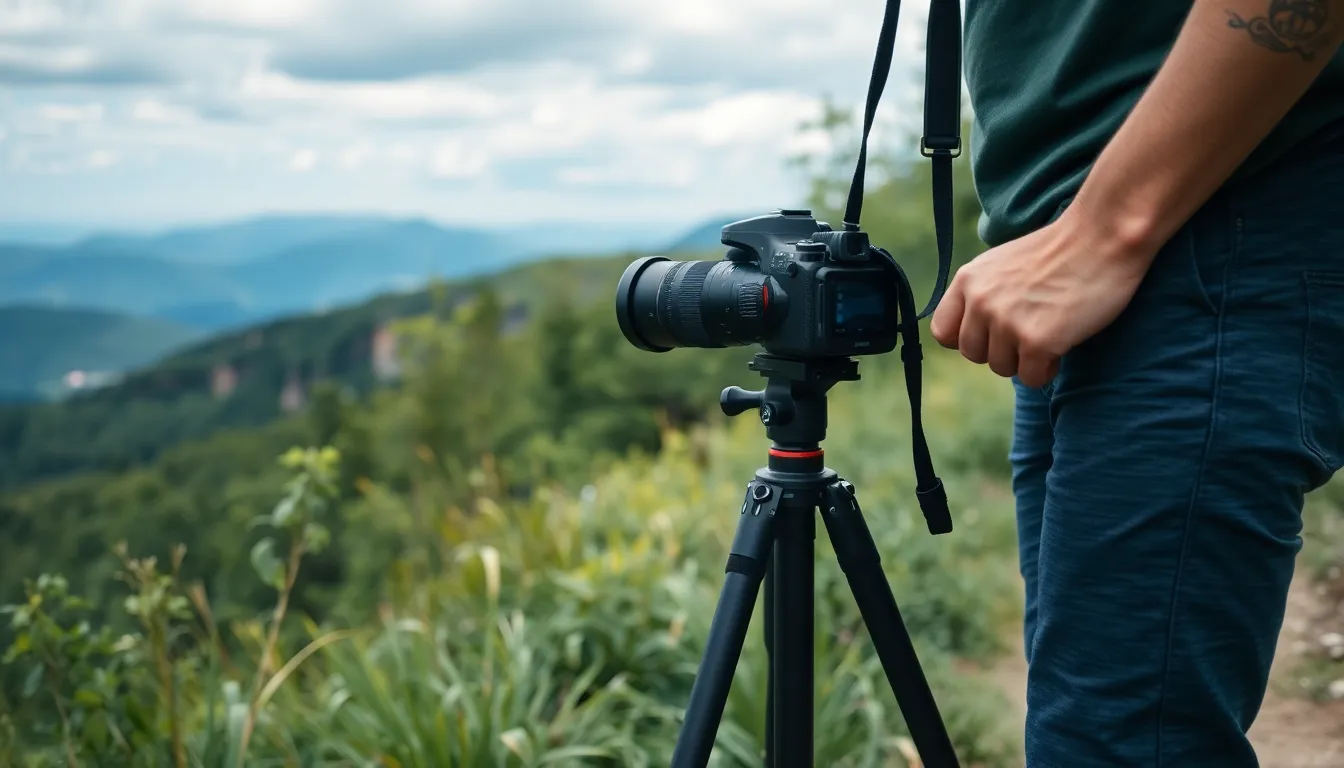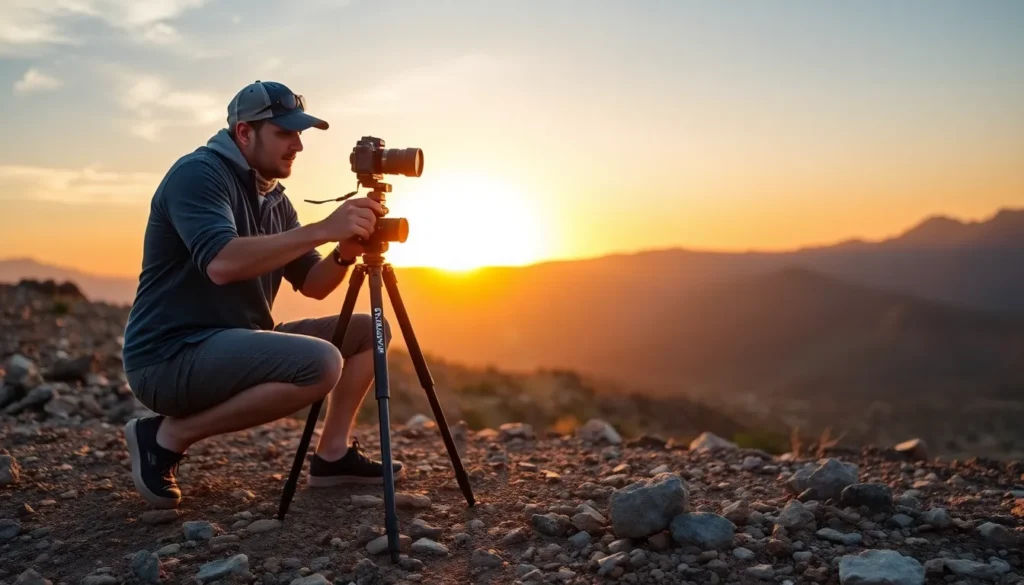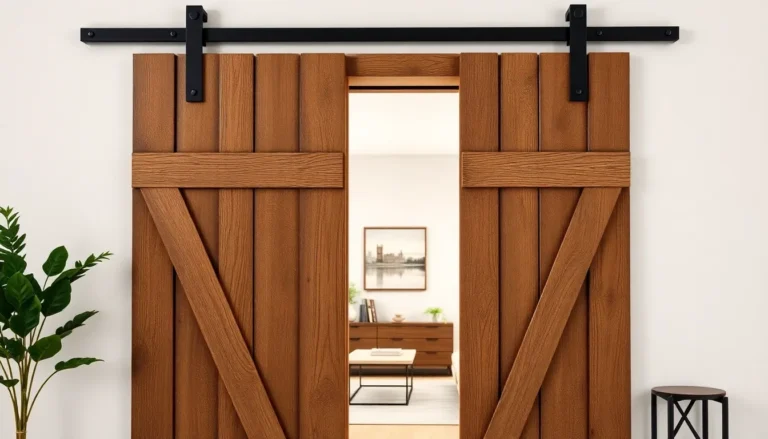Table of Contents
ToggleEvery photographer knows the struggle of that perfect shot—just when the light’s right, the camera wobbles like a toddler on roller skates. Enter the unsung hero of photography: the tripod. This trusty companion not only keeps the camera steady but also helps capture those breathtaking moments that would otherwise slip away faster than a cat at bath time.
Tripods come in all shapes and sizes, and finding the right one can feel like searching for a needle in a haystack. But fear not! With the right tripod, even the most novice photographer can achieve professional-quality shots. Whether it’s for landscapes, portraits, or those epic long-exposure night scenes, a good tripod is worth its weight in gold—or at least in camera gear. Let’s dive into the world of camera tripods and discover why they’re essential for anyone serious about their craft.
Overview of Camera Tripods
Camera tripods provide crucial stability for photographers, allowing them to capture sharp images without blur. Various models exist in the market, each catering to specific needs and environments. Photographers use lightweight tripods for travel, while heavier ones offer enhanced stability for studio work.
Materials such as aluminum and carbon fiber determine the weight and durability of the tripod. Aluminum tripods tend to weigh more but are budget-friendly, whereas carbon fiber tripods cost more yet deliver lightweight strength. Flexibility in design features sets tripods apart as well, with some offering adjustable legs and built-in levels.
Different types of tripods serve distinct purposes. Standard models suit general photography, while specialized ones, like gorilla pods and monopods, provide unique advantages in certain situations. Backpackers favor compact tripods that fit easily into luggage, finding portability essential during extended hikes.
Understanding the height range of a tripod is vital for ensuring optimal shooting angles. Many tripods extend up to 60 inches or more, accommodating various height requirements. Users should also consider the load capacity, which determines how much weight the tripod can support safely.
Additionally, many tripods come with features like quick-release plates, making it easy to switch between video and photo modes swiftly. The inclusion of adjustable legs enhances versatility, allowing photographers to capture landscapes from uneven ground efficiently. Investing in a sturdy tripod enhances creativity and elevates the overall quality of photographic work.
Types of Camera Tripods

Various types of camera tripods cater to different photography needs. Understanding these options helps in selecting the right tripod for specific situations.
Lightweight Tripods
Lightweight tripods typically weigh less than three pounds. These models often use aluminum or carbon fiber construction, making them ideal for travel photographers. Convenience plays a significant role here, as they easily fit into bags without adding extra weight. Stability remains essential; many lightweight options still provide sufficient support for standard DSLR or mirrorless cameras. Some include features like quick-release plates for fast setup. Versatility also shines, enabling use in various environments, from hiking trails to crowded events.
Heavy-Duty Tripods
Heavy-duty tripods cater to professional photographers needing maximum stability. Generally, these tripods can support heavier gear, often exceeding 20 pounds. They typically use robust materials, including aluminum or high-grade carbon fiber, ensuring durability and strength. Shooting in studio environments benefits significantly from the solid support these tripods provide. Adjustability often features prominently, allowing for different heights and angles to meet specific shooting requirements. Whether for portraits or long-exposure landscapes, these tripods enhance performance in demanding conditions.
Specialty Tripods
Specialty tripods encompass unique designs tailored to specific photography needs. Gorillapods offer flexible legs that can wrap around various surfaces, ideal for adventurous shooting positions. Monopods simplify movement, providing support without the bulk of a traditional tripod. Additionally, tabletop tripods serve well for low-angle shots and compact setups. These specialty models generally enhance creativity, enabling photographers to achieve perspectives that standard tripods may not accommodate. Understanding these diverse options empowers photographers to choose the most effective tool for their creative pursuits.
Key Features to Consider
Selecting the right tripod involves evaluating several key features that impact its performance. Understanding these features ensures a photographer makes an informed decision tailored to their needs.
Height and Weight Capacity
Height and weight capacity are crucial for effective tripod use. Tripods should accommodate the height of the user for optimal comfort. A tripod that extends between 50 to 70 inches provides flexibility for various shooting angles. Weight capacity varies from lightweight models supporting 5 pounds to heavy-duty options that can handle over 40 pounds. Choosing one with the appropriate weight capacity ensures safety for cameras and accessories throughout the photoshoot.
Material and Build Quality
Material and build quality greatly influence a tripod’s durability and weight. Aluminum offers a balance between cost and sturdiness, suitable for casual and travel photographers. Carbon fiber, while more expensive, provides lighter weight and superior shock absorption. High-quality build characteristics enhance a tripod’s overall stability and longevity. Additional features such as rubber feet and quality locking mechanisms contribute to a tripod’s reliability on different surfaces.
Stability and Design
Stability and design are integral for sharp images, especially in low-light conditions. A tripod’s ability to minimize vibrations plays a key role in image clarity. Many models include leg designs that resist sliding on uneven ground. Features such as adjustable leg angles and built-in bubble levels facilitate precise alignment. A well-designed tripod allows for quick adaptability in varying environments, enhancing the photographer’s ability to create remarkable images.
Brands and Models to Explore
Exploring various tripod brands and models can enhance the photography experience significantly.
Popular Brands
Manfrotto stands out for its durability and innovative designs. Gitzo appeals to professionals seeking lightweight options without compromising stability. Vanguard offers versatile tripods suitable for both beginners and seasoned photographers. Benro combines functional designs with affordability, making it a popular choice among enthusiasts. Additionally, Peak Design is recognized for its compact and travel-friendly models, perfect for on-the-go photographers.
Recommended Models
Manfrotto’s 190XPRO is known for versatility, accommodating different shooting styles. Gitzo’s Traveler Series excels in portability while supporting heavy gear. Vanguard’s Alta Pro 263AT provides flexible positioning for dynamic shots. Benro’s Adventure series features sturdy construction at an accessible price point. Peak Design’s Travel Tripod impresses with its sleek design and excellent functionality, ideal for travel. Each of these models showcases unique features aimed at enhancing photographers’ capabilities.
A camera tripod is more than just an accessory; it’s an essential tool that can elevate any photographer’s work. By providing stability and versatility, tripods enable photographers to explore new creative possibilities and capture stunning images in various conditions.
Choosing the right tripod tailored to individual needs can make a significant difference in the quality of photos. Whether opting for a lightweight model for travel or a heavy-duty design for studio work, the right tripod enhances the overall photography experience.
Investing in a quality tripod not only ensures safety for equipment but also empowers photographers to push their creative boundaries. With the right support, capturing that perfect shot becomes much more achievable.




